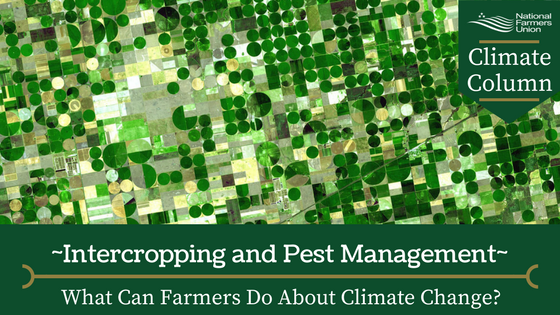 By Adam Pauley, NFU Intern
By Adam Pauley, NFU Intern
Last week on the Climate Column, we noted that milder winters caused by climate change are lengthening the lives of frost-sensitive pests, increasing pest pressure on farms. Farmers are implementing new practices to compete with more aggressive pests, but many of the common means of doing so can exacerbate other environmental concerns, like chemical runoff into neighboring bodies of water.
One solution to both of these problems is intercropping. According to U.S. Department of Agriculture (USDA) Natural Resources Conservation Service (NRCS), intercropping is the practice of growing two or more crops in close proximity to one another during part or all of their life cycles. While monocropping, the practice of only growing one crop variety year after year, leaves producers more vulnerable to pests that target a specific plant variety, intercropping, by providing additional plant varieties, can help slow the proliferation of pests and protect yields.
Intercropping can also be used to manage pests in more specific ways. One example of this is trap crops. According to University of Tennessee’s Institute of Agriculture, a trap crop is meant to attract pests, keeping them away from the main crop. Farmers using this method could decide to apply pesticides just to the trap crop rather than their entire field, cutting down on input costs.
In addition to managing pests, intercropping provides a number of ecological benefits. It promotes interactions between crops and pollinators, thus supporting biodiversity and wildlife species. Intercropping can also improve soil and water quality by reducing pesticide use, increasing vegetative cover, and diversifying root structure.
Have you experienced any changes in pests or weeds in recent years? Have you considered using intercropping? Please share your thoughts or experiences with intercropping in the comments below.
Like what you’ve read? Check out our Climate Leaders home page, join the conversation in the NFU Climate Leaders Facebook Group, and keep up-to-date with NFU climate action by signing up for the mailing list.

